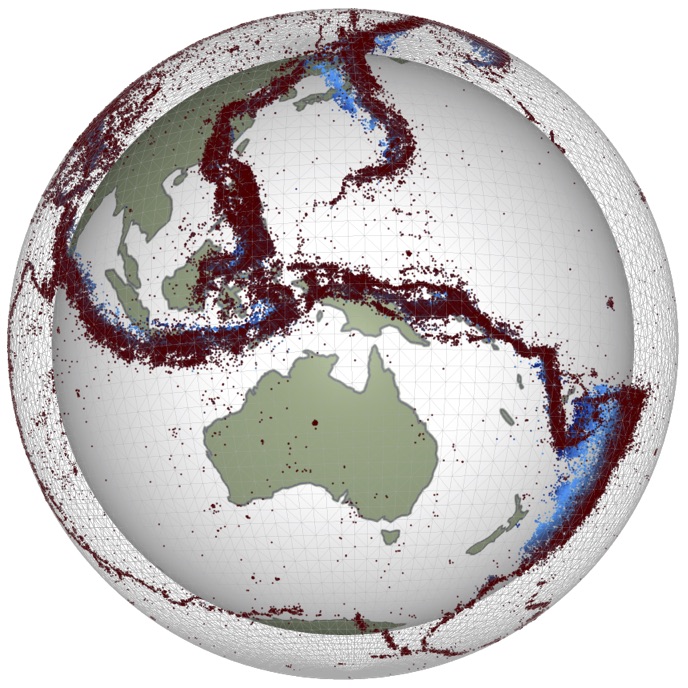Convection in a disc with internal heating and rigid or free boundaries#
# to fix trame issue
import nest_asyncio
nest_asyncio.apply()
import underworld3 as uw
from underworld3.systems import Stokes
from underworld3 import function
import os
import numpy as np
import sympy
import petsc4py
from petsc4py import PETSc
## Command line parameters use -uw_resolution 0.1, for example
res = uw.options.getReal("resolution", default=0.1)
Free_Slip = uw.options.getBool("free_slip", default=True)
restart_step = uw.options.getInt("restart_step", default=0)
max_steps = uw.options.getInt("max_steps", default=1)
delta_eta = uw.options.getReal("delta_eta", default=1000.0)
viz = True
uw.options.view()
Rayleigh = 1.0e7
H_int = 1.0
k = 1.0
resI = res * 3
r_o = 1.0
r_i = 0.0
# For now, assume restart is from same location !
expt_name = f"Disc_Ra1e7_H1_deleta_{delta_eta}"
output_dir = "output"
os.makedirs(output_dir, exist_ok=True )
meshball = uw.meshing.AnnulusWithSpokes(radiusOuter=r_o, radiusInner=r_i,
cellSizeOuter=res,
cellSizeInner=resI,
qdegree=3, )
meshball.dm.view()
radius_fn = sympy.sqrt(meshball.X.dot(meshball.X)) # normalise by r_o if required
unit_rvec = meshball.X / radius_fn
gravity_fn = radius_fn
# Some useful coordinate stuff
x = meshball.N.x
y = meshball.N.y
r = sympy.sqrt(x**2 + y**2) # cf radius_fn which is 0->1
th = sympy.atan2(y + 1.0e-5, x + 1.0e-5)
# check the mesh if in a notebook / serial
if viz and uw.mpi.size == 1:
import pyvista as pv
import underworld3.visualisation as vis
pvmesh = vis.mesh_to_pv_mesh(meshball)
pl = pv.Plotter(window_size=(750, 750))
pl.add_mesh(pvmesh, cmap="coolwarm", edge_color="Black", show_edges=True, use_transparency=False, opacity=0.5)
pl.show()
v_soln = uw.discretisation.MeshVariable("U", meshball, meshball.dim, degree=2)
p_soln = uw.discretisation.MeshVariable("P", meshball, 1, degree=1)
t_soln = uw.discretisation.MeshVariable("T", meshball, 1, degree=3)
t_0 = uw.discretisation.MeshVariable("T0", meshball, 1, degree=3)
r_mesh = uw.discretisation.MeshVariable("r", meshball, 1, degree=1)
kappa = uw.discretisation.MeshVariable("kappa", meshball, 1, degree=3, varsymbol=r"\kappa")
## F-K viscosity function
C = sympy.log(delta_eta)
viscosity_fn = delta_eta * sympy.exp(-C * 0)
# Create Stokes object
stokes = Stokes(meshball, velocityField=v_soln, pressureField=p_soln,
solver_name="stokes",
verbose=False)
# Constant viscosity
stokes.constitutive_model = uw.constitutive_models.ViscousFlowModel
stokes.constitutive_model.Parameters.shear_viscosity_0 = viscosity_fn
# Set solve options here (or remove default values
stokes.tolerance = 1.0e-6
# stokes.petsc_options.delValue("ksp_monitor")
stokes.petsc_options.setValue("ksp_monitor", None)
stokes.petsc_options.setValue("snes_monitor", None)
# Velocity boundary conditions
if Free_Slip:
GammaN = meshball.Gamma # boundary_normals["Upper"].value
# bc = sympy.Piecewise((1.0, r > 0.99 * r_o), (0.0, True))
stokes.add_natural_bc(
1.0e6 * GammaN.dot(v_soln.sym) * GammaN.T, "Upper"
)
else:
stokes.add_dirichlet_bc((0.0, 0.0), "Upper")
meshball.Gamma
# Create adv_diff object
adv_diff = uw.systems.AdvDiffusionSLCN(
meshball,
u_Field=t_soln,
V_fn=v_soln,
solver_name="adv_diff",
verbose=False,
order=2,
)
adv_diff.constitutive_model = uw.constitutive_models.DiffusionModel
## Flux limiting diffusivity (stabilizing term)
Tgrad = meshball.vector.gradient(t_soln.sym)
Tslope = sympy.sqrt(Tgrad.dot(Tgrad))
Tslope_max = 25
k_lim = (Tslope/Tslope_max)
k_eff = k * sympy.Max(1, k_lim)
adv_diff.constitutive_model.Parameters.diffusivity = k
adv_diff.f = H_int
## Projection to compute the diffusivity
calculate_diffusivity = uw.systems.Projection(meshball, u_Field=kappa)
calculate_diffusivity.uw_function = k_eff
# Define T boundary conditions via a sympy function
import sympy
abs_r = sympy.sqrt(meshball.rvec.dot(meshball.rvec))
init_t = 0.25 + 0.25 * sympy.sin(7.0 * th) * sympy.sin(np.pi * (r - r_i) / (r_o - r_i)) + 0.0 * (r_o - r) / (r_o - r_i)
adv_diff.add_dirichlet_bc(0.0, "Upper")
with meshball.access(t_0, t_soln):
t_0.data[...] = uw.function.evalf(init_t, t_0.coords).reshape(-1, 1)
t_soln.data[...] = t_0.data[...]
# If restart, then pull T from there
if restart_step != 0:
t_soln.read_timestep(expt_name, "T", restart_step, outputPath=output_dir, verbose=True)
with meshball.access(r_mesh):
r_mesh.data[:, 0] = uw.function.evalf(r, meshball.data)
stokes.bodyforce = unit_rvec * gravity_fn * Rayleigh * t_soln.fn
stokes.solve(verbose=False)
# Check the diffusion part of the solve converges
dt = 0.00001
adv_diff.solve(timestep=dt)
adv_diff.constitutive_model.Parameters.diffusivity = k_eff
adv_diff.solve(timestep=dt, zero_init_guess=False)
calculate_diffusivity.solve()
# check the mesh if in a notebook / serial
if viz and uw.mpi.size == 1:
import pyvista as pv
import underworld3.visualisation as vis
pvmesh = vis.mesh_to_pv_mesh(meshball)
pvmesh.point_data["T"] = vis.scalar_fn_to_pv_points(pvmesh, t_soln.sym[0])
pvmesh.point_data["K"] = vis.scalar_fn_to_pv_points(pvmesh, kappa.sym[0])
velocity_points = vis.meshVariable_to_pv_cloud(stokes.u)
velocity_points.point_data["V"] = vis.vector_fn_to_pv_points(velocity_points, stokes.u.sym)
pl = pv.Plotter(window_size=(750, 750))
# pl.add_mesh(pvmesh,'Black', 'wireframe')
pl.add_mesh(
pvmesh, cmap="coolwarm", edge_color="Black",
show_edges=True, scalars="T",
use_transparency=False, opacity=1.0,
# clim=[0,1],
)
pl.add_arrows(velocity_points.points, velocity_points.point_data["V"], mag=0.01)
# pl.add_arrows(arrow_loc2, arrow_length2, mag=1.0e-1)
# pl.add_points(pdata)
pl.show(cpos="xy")
def plot_T_mesh(filename):
if viz and uw.mpi.size == 1:
import pyvista as pv
import underworld3.visualisation as vis
pvmesh = vis.mesh_to_pv_mesh(meshball)
pvmesh.point_data["T"] = vis.scalar_fn_to_pv_points(pvmesh, t_soln.sym)
points = vis.meshVariable_to_pv_cloud(t_soln)
points.point_data["T"] = vis.scalar_fn_to_pv_points(points, t_soln.sym)
point_cloud = pv.PolyData(points)
velocity_points = vis.meshVariable_to_pv_cloud(stokes.u)
velocity_points.point_data["V"] = vis.vector_fn_to_pv_points(velocity_points, stokes.u.sym)
pl = pv.Plotter(window_size=(750, 750))
pl.add_arrows(velocity_points.points, velocity_points.point_data["V"], mag=50 / Rayleigh)
pl.add_mesh(pvmesh, cmap="coolwarm",
show_edges=True,
scalars="T", opacity=0.75)
pl.add_points(point_cloud, cmap="coolwarm",
render_points_as_spheres=False,
# clim=[0,1],
point_size=10, opacity=0.66)
# pl.remove_scalar_bar("T")
pl.remove_scalar_bar("mag")
pl.screenshot(filename="{}.png".format(filename), window_size=(1280, 1280), return_img=False)
# pl.show()
ts = restart_step
# Convection model / update in time
delta_t = 5.0e-5
for step in range(0, max_steps ): #
stokes.solve(verbose=False, zero_init_guess=False)
calculate_diffusivity.solve()
if step%10 == 0:
delta_t = adv_diff.estimate_dt(v_factor=2.0, diffusivity=kappa.sym[0])
adv_diff.solve(timestep=delta_t, zero_init_guess=False )
# stats, dt (all collective) print if rank 0, then loop
tstats = t_soln.stats()
Tgrad_stats = kappa.stats()
dt_estimate = adv_diff.estimate_dt(v_factor=2.0, diffusivity=kappa.sym[0])
if uw.mpi.rank == 0:
print("Timestep {}, dt {} ({})".format(ts, delta_t, dt_estimate), flush=True)
# print(tstats)
# print("-----")
# print(Tgrad_stats)
# print("=====\n")
# print(tstats_star)
if ts % 10 == 0:
plot_T_mesh(filename="output/{}_step_{}".format(expt_name, ts))
meshball.write_timestep(
expt_name,
meshUpdates=True,
meshVars=[p_soln, v_soln, t_soln],
outputPath=output_dir,
index=ts,
)
ts += 1
if viz and uw.mpi.size == 1:
import pyvista as pv
import underworld3.visualisation as vis
pvmesh = vis.mesh_to_pv_mesh(meshball)
pvmesh.point_data["T"] = vis.scalar_fn_to_pv_points(pvmesh, t_soln.sym)
points = vis.meshVariable_to_pv_cloud(t_soln)
points.point_data["T"] = vis.scalar_fn_to_pv_points(points, t_soln.sym)
point_cloud = pv.PolyData(points)
velocity_points = vis.meshVariable_to_pv_cloud(stokes.u)
velocity_points.point_data["V"] = vis.vector_fn_to_pv_points(velocity_points, stokes.u.sym)
pl = pv.Plotter(window_size=(750, 750))
pl.add_arrows(velocity_points.points, velocity_points.point_data["V"], mag=0.01, opacity=0.75)
# pl.add_arrows(arrow_loc2, arrow_length2, mag=1.0e-1)
pl.add_points(point_cloud, cmap="coolwarm",
render_points_as_spheres=True,
point_size=7.5, opacity=0.25)
pl.add_mesh(pvmesh, cmap="coolwarm", scalars="T", opacity=0.75)
pl.show(cpos="xy")
